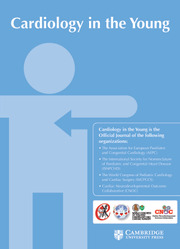No CrossRef data available.
Article contents
New triple combination therapy approach for children with advanced heart failure despite having received standard heart failure treatment
Published online by Cambridge University Press: 01 September 2025
Abstract
The limited efficacy of monotherapy and the insufficient clinical experience with triple therapy (levosimendan, dapagliflozin, and sacubitril/valsartan) warrant further investigation. The aim of this study was to evaluate the effects of triple therapy on left ventricular function in children with advanced heart failure whose left ventricular function had not improved despite classical heart failure treatment and who remained dependent on inotropes.
The study included children who were admitted to the hospital with advanced heart failure and who were still inotrope-dependent at a mean of 42 days after the start of classical heart failure treatment and then started triple therapy at our hospital.
The study included 18 patients, 8 (44%) males, with a median age of 4 years (2–7 years). Before and after classical treatment and after triple treatment, statistically significant improvement in two-dimensional left ventricular ejection fraction (%) (median values 30; 38; 55, respectively), left ventricular end-diastolic diameter (median values 44; 45; 40 mm), left ventricular end-systolic diameter (median values 38; 36; 29 mm), left ventricular end-diastolic diameter (z score) (median values 4.2; 3.2; 2.7), left ventricular end-systolic diameter (z score) (median values 5.8; 4.8; 3.2), Simpson left ventricular ejection fraction (%) (median values 29; 36.5; 55), Simpson left ventricular end-diastolic volume (median values 60; 55; 43 ml), left ventricular end-systolic volume (median values 43; 40; 18. 5 ml), left ventricular global longitudinal strain four-chamber (median values -8.1;-10;-19), left ventricular global longitudinal strain three-chamber (median values -5.9;-8.9;-14), and left ventricular global longitudinal strain mean (median values -6.9;-9.7;-19) values was observed (all values p < 0.05).
In children admitted to the hospital with advanced heart failure whose left ventricular function has not improved with classical therapy, it seems likely that both left ventricular systolic and diastolic function will improve, inotrope dependency will resolve, and patients can be discharged with the new triple drug therapy.
Information
- Type
- Original Article
- Information
- Copyright
- © The Author(s), 2025. Published by Cambridge University Press


